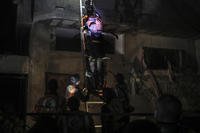Navy inspectors have praised the fleet's third littoral combat ship, the Freedom-class USS Fort Worth, but the rest of the program continued its whirlpool churn.
LCS program boss Rear Adm. Jim Murdoch told reporters Wednesday that the Fort Worth had fewer than ten "starred cards" -- significant problems found when the Navy inspected the ship before taking delivery -- as compared to the more than 50 the Freedom had back in its day.
But even at the very moment he and another admiral were talking to reporters on a conference call, California Rep. Jackie Speier was blasting LCS, becoming the latest lawmaker to urge Congress' watchdog, the Government Accountability Office, to look into the state of the program.
“It's disturbing that the Navy would accept a ship that fails to meet the basic requirements for a tugboat," Speier said in a statement. "The future of the fleet is corroding before our eyes. I find it troubling that it takes whistleblowers and the press to bring these problems to light. It's time for an independent assessment to find out what's really going on with this program.”
That skepticism could not have contrasted more with the upbeat picture painted by Murdoch and the Navy Staff's surface warfare boss, Rear Adm. Thomas Rowden. They convened their conference call to push what they called a string of good news about LCS: The Fort Worth's high quality; the arrival of the second ship, the USS Independence, in San Diego; and the Freedom's return to sea to prepare for its deployment next year to Singapore.
With LCS, however, progress often isn't progress. Although Murdoch and Rowden said the Independence had a good transit from Florida to California, they acknowledged the Navy had deliberately decided not to attempt a "trial deployment" branding as it had with the Freedom, giving the ship more days at sea to chase drug runners or operate with other American warships. That's because the Navy is under the gun to complete operational testing of the LCS mine countermeasures module to meet the terms of a deal its leaders made with DoD's test and evaluation gurus. It's going OK, Murdoch said, but it means that there is apparently no deployment, even a pretend one, now on the radar screen for LCS 2.
As for the Freedom, inspectors from Naval Surface Forces panned it earlier this month in a visit to see if it was ready for the real make-or-break visit by the Board of Inspection and Survey. INSURV is a dread power in the fleet, as its inspectors and reports give painful details about whether ships and crews are ready to fight. After a few bruising years of INSURV failures, fleet commanders began setting up their own pre-training and pre-inspections to make sure ships were ready, or at least to give a good preview about how a ship might do. When SurFor visited LCS 1, it concluded the ship was not ready for prime time.
As posted Wednesday by Galrahn, the Freedom's "TYCOM material inspection" report deemed it was a "no-go" and described confusion between the ship's company and its contractors over who was responsible for which elements onboard. LCS is novel, among many other ways, in that it relies much more on contractors to help keep things running, to account for the smaller crew. Murdoch and Rowden said Wednesday they didn't think the report "set off any alarm bells," but they did acknowledge it showed that the ship still is figuring things out, feeling its way along, and so on.
"We're making it up as we go" and "We don't even know what it is yet!" are two Big Navy rallying cries for LCS, and they're also two reasons why the program continues to have so many skeptics in and out of uniform. People want a ship to be a ship, not for a multi-billion dollar defense program to be a free-form jazz odyssey.
Murdoch and Rowden, for their part, said they welcomed criticism and they understood why there remain many pockets of resistance to LCS. The ships are so different, they said, it's no wonder why they have trouble winning converts, but the constant friction surrounding the program "Helps us sharpen our focus on what we need to go work on," Rowden said. The admirals' bottom line remains that LCS is the right ship, end of story.
The next big priority is getting the Freedom and its crews ready for their deployment next spring. The ship will be away for about 10 months, Rowden said, operating out of Singapore. It'll be a trial for swapping crews, changing mission modules -- or at least simulating as much -- and supporting and sustaining LCS according to its evolving concept of operations. Rowden acknowledged the surface Navy does not have much experience in doing the things it'll need to do to make LCS work, which is why the Freedom's trip will be so important. It'll require about 40 people, sailors and contractors, working in Singapore to support the deployment, he said.
The stakes are high. As we've observed so often before, the Navy needs LCS to do something; even its biggest booster, Navy Undersecretary Robert Work, acknowledges it still must prove itself in the real world. The program is not in danger -- "Our sense is, congressional support for the block buy remains solid," Murdoch said -- but everything would sure go a lot smoother if the Navy could placate many of the LCS critics. Even so, these ships may never fully shake controversy.
The point of LCS was supposed to be flexibility and modularity, but there’s a case to be made that actually the Navy has built something that does just the opposite – puts it in a straitjacket. The flush-years, Rumsfeld-era Navy that created LCS is long gone, and now second and third generations of leaders are trying to take something sold as "adaptable" and actually shoehorn it to their different needs.
Navy leaders shrug and smile and say, hey, we can do whatever we want: So we won’t run the ships at their high speeds and, if we need to, yeah, we’ll add more crewmembers. But this can start to sound like a new father making excuses to keep his sporty convertible after the baby is born -- yes, you might be able to squeeze a car seat back there, but it's never going to be a Volvo station wagon.
Adding more sailors and getting rid of speed may sound like “adaptation,” but it’s also “compromise:” The Navy has already had to concede that LCS will only take four-month deployments, instead of the surface Navy’s standard six. Each new reduction in speed, change in design and addition of crew makes LCS a little less LCS and more of a standard surface warship. There’s nothing wrong with that, but if that's what the Navy wants, why not build it? (The answer is that the program is too far along and the brass can't turn back now.)
Some Navy leaders, including Fleet Forces Command boss Adm. John Harvey, have warned against exactly this mentality – we can’t force LCS to come to us, he argues; we’ve got to go to it. Still, he and the rest of the leadership are hamstrung by how slowly the program is playing out. The Navy dropped the onetime urgency it attached to the program, choosing instead to sit back and relax. At this rate, it can feel like the future LCS was supposed to deliver might never arrive.








